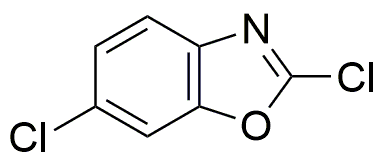2,6-Dichlorobenzoxazole is widely utilized in research focused on:
- Pharmaceutical Development: This compound serves as a key intermediate in the synthesis of various pharmaceuticals, particularly in the development of anti-inflammatory and antimicrobial agents.
- Analytical Chemistry: It is used as a reagent in analytical methods to detect and quantify certain biological molecules, aiding researchers in drug formulation and quality control.
- Material Science: The compound is employed in the production of specialty polymers and coatings, enhancing material properties such as thermal stability and chemical resistance.
- Agricultural Chemistry: It finds applications in the formulation of agrochemicals, contributing to the development of effective herbicides and fungicides that improve crop yields.
- Environmental Research: Researchers utilize it to study the degradation pathways of chlorinated compounds, helping to assess environmental impact and develop remediation strategies.
General Information
Properties
Safety and Regulations
Applications
2,6-Dichlorobenzoxazole is widely utilized in research focused on:
- Pharmaceutical Development: This compound serves as a key intermediate in the synthesis of various pharmaceuticals, particularly in the development of anti-inflammatory and antimicrobial agents.
- Analytical Chemistry: It is used as a reagent in analytical methods to detect and quantify certain biological molecules, aiding researchers in drug formulation and quality control.
- Material Science: The compound is employed in the production of specialty polymers and coatings, enhancing material properties such as thermal stability and chemical resistance.
- Agricultural Chemistry: It finds applications in the formulation of agrochemicals, contributing to the development of effective herbicides and fungicides that improve crop yields.
- Environmental Research: Researchers utilize it to study the degradation pathways of chlorinated compounds, helping to assess environmental impact and develop remediation strategies.
Documents
Safety Data Sheets (SDS)
The SDS provides comprehensive safety information on handling, storage, and disposal of the product.
Product Specification (PS)
The PS provides a comprehensive breakdown of the product’s properties, including chemical composition, physical state, purity, and storage requirements. It also details acceptable quality ranges and the product's intended applications.
Certificates of Analysis (COA)
Search for Certificates of Analysis (COA) by entering the products Lot Number. Lot and Batch Numbers can be found on a product’s label following the words ‘Lot’ or ‘Batch’.
*Catalog Number
*Lot Number
Certificates Of Origin (COO)
This COO confirms the country where the product was manufactured, and also details the materials and components used in it and whether it is derived from natural, synthetic, or other specific sources. This certificate may be required for customs, trade, and regulatory compliance.
*Catalog Number
*Lot Number
Safety Data Sheets (SDS)
The SDS provides comprehensive safety information on handling, storage, and disposal of the product.
DownloadProduct Specification (PS)
The PS provides a comprehensive breakdown of the product’s properties, including chemical composition, physical state, purity, and storage requirements. It also details acceptable quality ranges and the product's intended applications.
DownloadCertificates of Analysis (COA)
Search for Certificates of Analysis (COA) by entering the products Lot Number. Lot and Batch Numbers can be found on a product’s label following the words ‘Lot’ or ‘Batch’.
*Catalog Number
*Lot Number
Certificates Of Origin (COO)
This COO confirms the country where the product was manufactured, and also details the materials and components used in it and whether it is derived from natural, synthetic, or other specific sources. This certificate may be required for customs, trade, and regulatory compliance.

